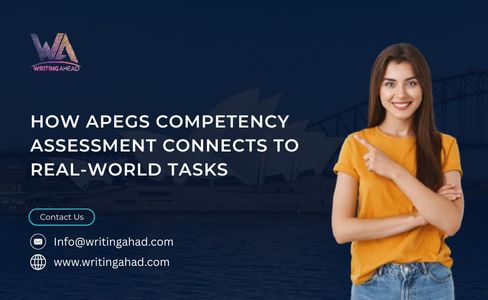How APEGS Competency Assessment Connects to Real-World Tasks
 Skyla Wilson
10 Aug, 2025
14 mins read
19
Skyla Wilson
10 Aug, 2025
14 mins read
19

The APEGS competency assessment process is an essential requirement for engineering professionals seeking licensure through the Association of Professional Engineers and Geoscientists of Saskatchewan (APEGS). It bridges the gap between academic knowledge and practical experience by requiring candidates to demonstrate competency through real-world professional tasks. The APEGS Report is more than a formal document—it is an authentic representation of one’s applied skills in dynamic, real-world engineering contexts. Understanding how this competency-based framework mirrors practical engineering environments is crucial for professionals aiming to meet licensure expectations. This article explores how the apegs competency assessment is rooted in real-world applications, what evaluators look for, and how the APEGS Report becomes a platform to reflect genuine workplace proficiency.
The Core Concept of Competency-Based Assessment
Practical Over Theoretical Knowledge
Unlike academic evaluations that focus primarily on theories and principles, the apegs competency assessment is designed to measure an applicant’s ability to perform engineering tasks in professional environments. The emphasis is placed on how well an individual can apply engineering knowledge to real-world challenges—demonstrating communication, ethical behavior, project management, problem-solving, and technical acumen.
Structured Around Competency Categories
The APEGS framework divides competencies into key categories such as technical competence, communication, project and financial management, and professional accountability. Each category is designed to reflect areas where professionals interact with actual projects, clients, stakeholders, and regulations.
Translating Competencies into Real-World Contexts
Technical Competency and Field Application
Real-world engineering tasks demand the application of complex technical principles under strict safety, quality, and efficiency standards. The APEGS Report requires candidates to show evidence of work involving calculations, material specifications, or systems design. These are not hypothetical but actual field-driven experiences.
For instance, detailing how you designed a mechanical system for a processing facility or reviewed structural load calculations on-site reveals how theoretical knowledge turns into functional results. These scenarios must be described clearly and concisely to prove your practical understanding.
Project Management and Execution
Effective project execution requires engineers to coordinate teams, manage schedules, allocate resources, and maintain client expectations. The apegs competency assessment includes this aspect through specific indicators related to time management, cost estimation, and risk control.
Candidates must reflect on their role in these areas. A successful APEGS Report example might describe how the applicant handled vendor delays, adjusted the project timeline, and communicated updates with stakeholders—an accurate depiction of real project dynamics.
Communication Skills in Professional Settings
Clear and Purposeful Engineering Communication
In practice, engineers must relay technical information to various audiences, from executives to technicians. This requires clarity, precision, and an understanding of audience-specific language. The APEGS Report asks for examples where applicants presented reports, conducted briefings, or collaborated through written communication.
A candidate might describe how they wrote technical reports for senior engineers or delivered design presentations to municipal clients, translating complex data into actionable items. These experiences illustrate a key real-world competency: making engineering knowledge accessible and useful.
Collaboration with Diverse Teams
Another real-world reflection in the apegs competency assessment is teamwork. Engineers rarely work in isolation. The assessment expects detailed descriptions of inter-departmental collaboration, conflict resolution, and cross-functional alignment.
For instance, collaborating with the procurement team to ensure material compliance or coordinating with environmental consultants during site assessments are rich examples that show practical interaction and soft-skill deployment.
Ethical Practice and Accountability in Professional Roles
Upholding Integrity in Engineering
The APEGS Report expects applicants to show their understanding of ethical responsibilities, not just knowledge of codes. This means identifying real-life scenarios where ethical decisions had to be made—whether related to safety, confidentiality, or conflict of interest.
For example, disclosing an error in design calculations and initiating a correction plan despite time and budget constraints demonstrates professional integrity and accountability. These reflections showcase how ethical standards guide decision-making in authentic work environments.
Regulatory Compliance in Daily Operations
Engineers must work within regulatory frameworks and standards. This competency is demonstrated through examples where the applicant ensured projects complied with applicable guidelines or managed audits. The apegs competency assessment ensures professionals are aware of their legal and regulatory duties, not merely from textbooks but through personal, professional conduct.
Leadership and Decision-Making in Practice
Managing Teams and Guiding Junior Engineers
Professionals are often tasked with mentoring junior staff or leading technical teams. The APEGS Report provides space to reflect on leadership scenarios—assigning tasks, reviewing work, and providing constructive feedback.
If you led a design team and delegated responsibilities based on team members’ strengths, this example strengthens your claim to leadership competency. This reflects how engineering leadership is exercised daily, not just during emergencies or big decisions.
Strategic Decision-Making
Another aspect is how decisions are made under uncertainty. The apegs competency assessment values examples where candidates selected between alternative solutions, managed limited resources, or assessed project risks. This mirrors real engineering decision-making, which is seldom linear or simple.
An effective example may include selecting an energy-efficient system that increased initial costs but reduced long-term operational expenses. Explaining the rationale and long-term benefit showcases analytical thinking.
Tailoring Your APEGS Report to Real Experiences
Avoiding Hypothetical Scenarios
To pass the apegs competency assessment, one must ensure every example is grounded in a real scenario. Hypothetical examples or academic projects without workplace relevance do not fulfill the requirement. The use of "I" instead of "we" further strengthens the credibility of personal contributions.
Aligning Experiences with Indicators
Each competency category has detailed indicators. Successful applicants tie their experiences directly to these indicators, showing not just what they did but why it mattered. A strong APEGS Report will reflect real consequences—such as improved safety, cost savings, or enhanced workflow efficiency.
Challenges in Connecting Tasks with Competencies
Overcoming Limited Exposure
Not all engineers have equal exposure to every aspect of the competency framework. For example, a design engineer may have limited experience in procurement or financial management. Yet, with reflection, even minor involvement can be transformed into valid examples. Participating in a cost-benefit meeting or assisting in vendor selection can serve as valuable evidence.
Gaps in Documentation
Some professionals may struggle to remember past project details. To bridge this, it's essential to start early, collect supporting documents, and speak with supervisors. The apegs competency assessment is as much about documenting the journey as it is about proving qualifications.
Conclusion
The APEGS competency assessment is a carefully structured process that ties professional licensing to practical, real-world engineering tasks. It ensures that aspiring professionals are not only technically qualified but also capable of performing their duties ethically, efficiently, and collaboratively in actual work environments.
The APEGS Report becomes the bridge between education and licensure, transforming project experiences into verified proof of competence. By aligning your documentation with lived professional tasks, you not only fulfill APEGS requirements but also deepen your own understanding of what it means to be a practicing engineer.
FAQs
How does the APEGS Report prove real-world engineering experience?
The APEGS Report includes detailed accounts of actual engineering work completed by the applicant. It focuses on practical tasks, responsibilities, and results to verify that the candidate can operate effectively in a real-world engineering environment.
What types of tasks are relevant for the APEGS competency assessment?
Tasks that involve technical design, project planning, ethical decisions, and professional collaboration are relevant. These should reflect actual responsibilities undertaken in the workplace, not classroom projects or simulated environments.
Can I use the same project for multiple competencies in the APEGS Report?
Yes, a single project may demonstrate multiple competencies. However, you must distinctly address each competency indicator and avoid repetitive explanations to ensure clarity and alignment with APEGS standards.
How important is it to use “I†statements in the APEGS Report?
Using “I†statements is crucial. The assessors are interested in your personal role, decisions, and impact—not your team's. This helps them evaluate your individual competencies and suitability for licensure.
What if I lack experience in a particular competency area?
You can use indirect or partial involvement examples if full exposure is missing. Mentorship, joint decision-making, or participation in discussions may still demonstrate understanding and contribution to that area.
Written By:
Skyla Wilson



Hotels at your convenience
Now choose your stay according to your preference. From finding a place for your dream destination or a mere weekend getaway to business accommodations or brief stay, we have got you covered. Explore hotels as per your mood.


